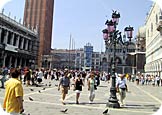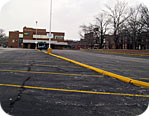 |
|||||||||
|
| home | our mission | contact us | issue archive |

Jul 2001 / from the editor :: email this story to a friend

Shifting Out of Park
By Brian H. Marston
"We have spent the last seventy years making driving convenient and life inconvenient. Well, as I've said before, what has been built can be unbuilt, and something new put in its place.... If we begin, little by little, making driving less convenient, eventually we will get around to making human life more convenient — and we might at last put the civility back into civilization." — Richard Risemberg, "Cars, Culture, Concrete, and Convenience"

As faithful readers of The Commonspace newsletter know, Amanda and I recently took a trip to Italy. The most unique city on our tour was Venice. Built in the middle of a lagoon on 100 low islands connected by 400 bridges, Venice is a most improbable place. It floods about 60 times a year and is propped up by millions of wood pilings driven into the mud. Given its location, it's hard to believe that Venice is able to survive at all, yet it's been a city for 1,500 years and was once the world's richest center of commerce.
One of the most striking things about Venice is the fact that there are no cars or Vespas in the entire city. Venice, the medieval Gateway to the Orient, is probably the most pedestrian-friendly, human-scale city in the world.
Back home in the Gateway to the West, things are a little different. Single-passenger cars are the preferred means of getting from one place to another, and the parking bugaboo is at the heart of every development plan. The availability of adjacent parking (and lots of it) is widely regarded as a make or break issue. When developers draw up plans, their first concern is often where they're going to put the cars. People and architecture are secondary considerations. Suburban-style ranch homes are a classic expression of this obsession with the automobile; from the street, they look like garages with attached homes.

The over-emphasis on parking is especially strange in a city that does not have a parking shortage. I can go anywhere in St. Louis at any time of the day and quickly find a parking spot within a few blocks of my destination. Try doing that in San Francisco, Chicago, or New York. Unlike St. Louis, world-class cities aren't covered with sprawling surface parking lots. Yet, people flock to them because they're exciting places to be. They're not worrying about what to do with their cars; miraculously, they figure out how to get around, even though parking is tight.
In the long run, the only way to save the historic buildings that give St. Louis its unique character and that could be cornerstones of redevelopment is to make our public transportation system more palatable to more people. Without convenient, efficient and pleasant mass transit, the growing car population will gobble up more and more land for surface parking.
Talk of public transportation, carpooling, and bicycling causes many folks to roll their eyes and say, "St. Louisans won't do that." Well of course they won't, if developers and planners continue to make it as convenient as possible for people to drive their private automobiles everywhere.
People will make the effort to get to and from a unique destination even if they can't park right in front of the door. It's the grotesquely prosaic big box stores and strip malls that have to entice customers with enormous seas of asphalt. If you can't be interesting, you better be convenient, or at least seem like you're convenient. Big chain stores have to offer easy-in, easy-out access because nobody wants to spend more time there than they have to.
All across America, developers are busily building towns and cities full of places where no one wants to be. It's time to stop and put people back at the center of the development equation. Doing so will require a change in values to embrace the attitude that cities should be built for people, not cars. If you think it can't be done, take a trip to Venice.
Church and State | Games | Expatriates | Communities | From the Source
It's All Happening | Young Minds | The Ordinary Eye | Elsewhere
Sights and Sounds | Media Shoegaze | A Day's Work | From the Editor© 2001 The Commonspace